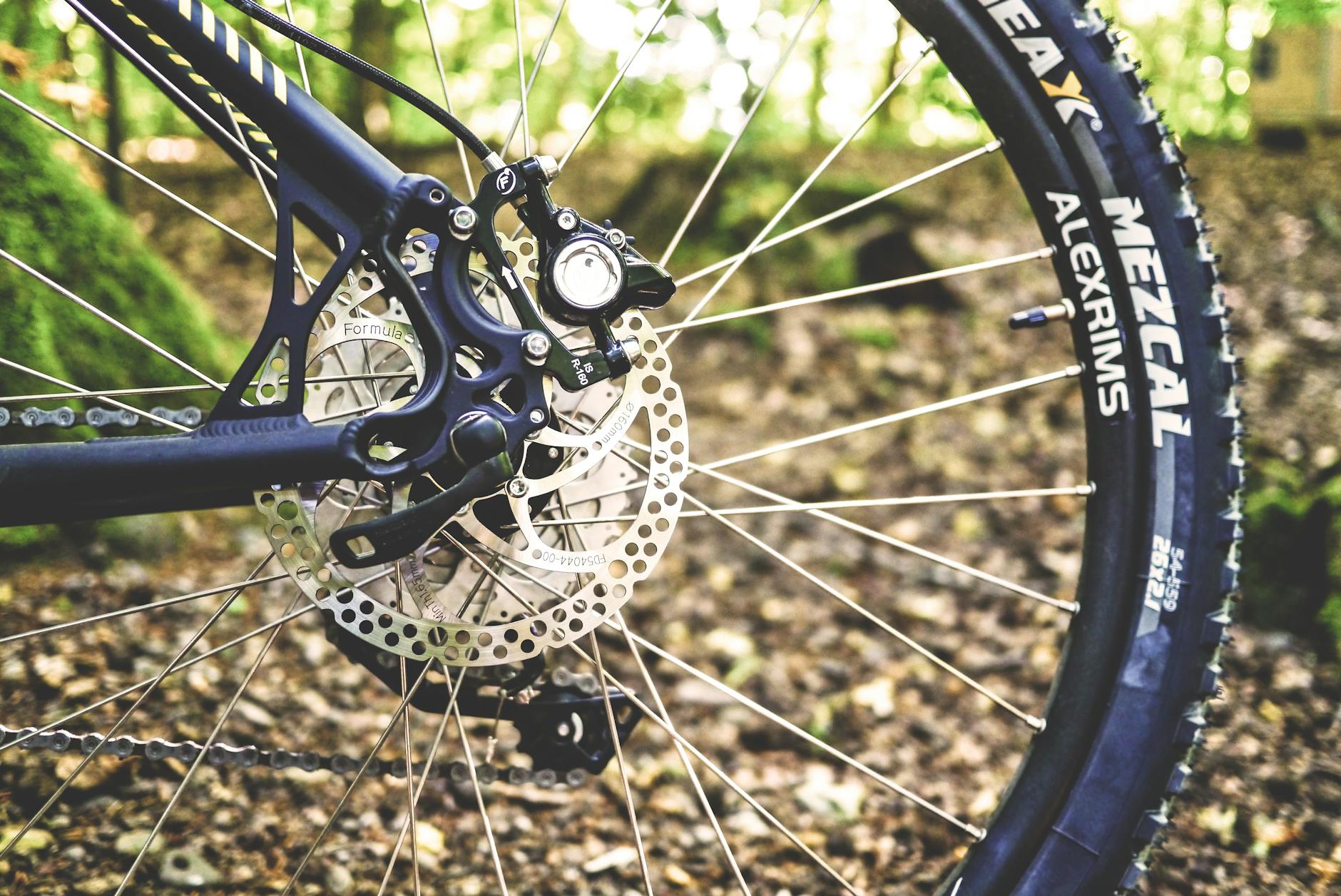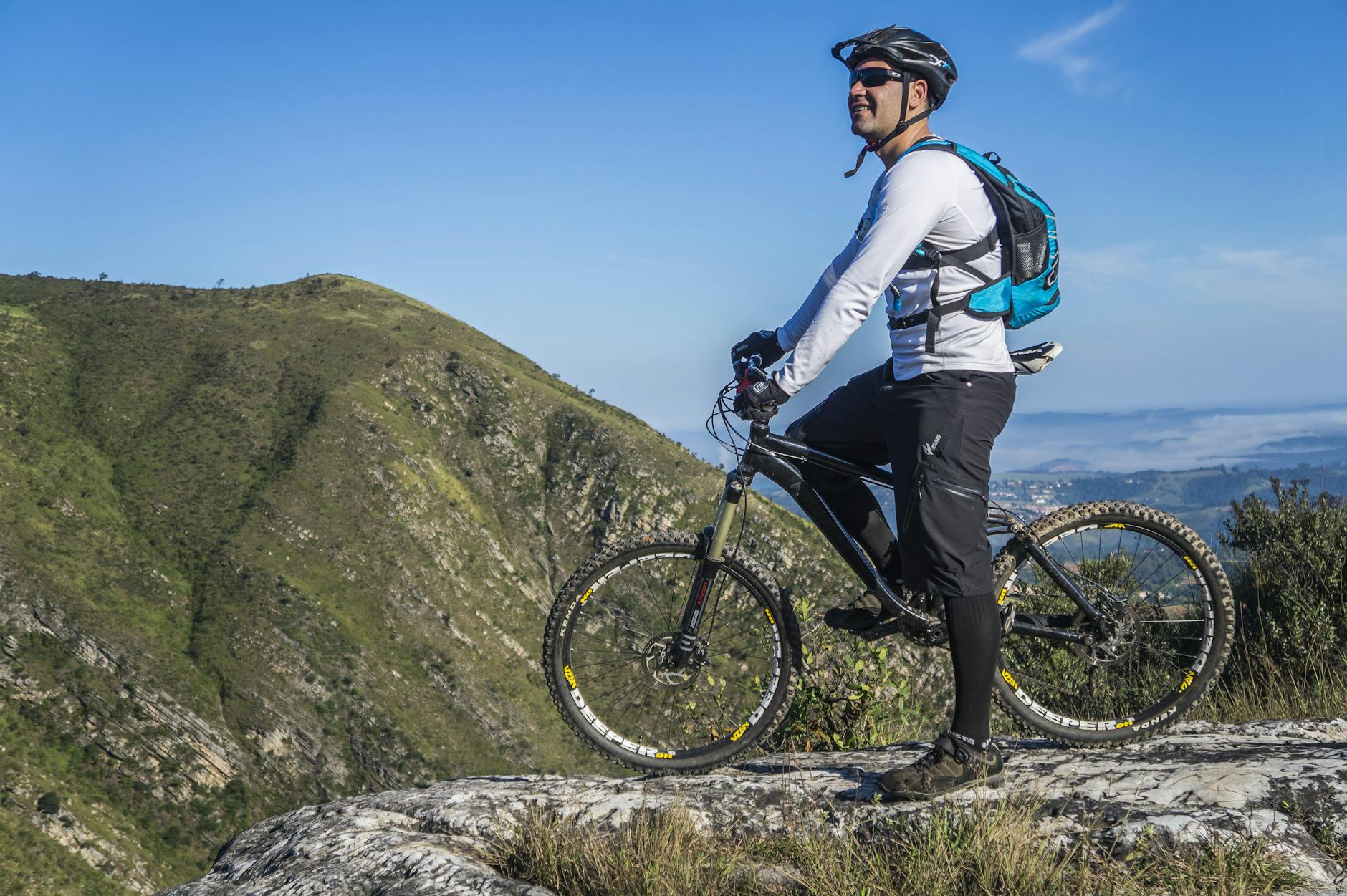
Like most kids, I loved riding my bike. It didn’t matter if it was a hand-me-down or a garage sale special–the joy was in the riding itself. But as an adult, I wanted to do more than ride around the block so I did some research on mountain bikes and here’s what I found.
*This post may contain affiliate links. As an Amazon Associate we earn from qualifying purchases.
What is a mountain bike? Simply put, a mountain bike is a cycle for rougher terrains. It’s intended for “off-roading” on unpaved trails like dirt, rocks, sand, or gravel.
So a mountain bike is meant for riding on rough terrain, but not all mountain bikes are created equal. They come in different types, sizes and price ranges. So how do you know which one is right for you? I’ve outlined below the information I found helpful when choosing my first mountain bike.
Road Bike vs Mountain Bike
One of the first things you might be wondering is whether a mountain bike is the right type of bike for you. Maybe you don’t plan to tackle trails that are too difficult or want a bike that can handle many surface types. Here are the basic differences:
ROAD BIKE
What is a road bike? Road bikes are built for speed. They are lightweight, and the narrow wheels reduce traction on smooth surfaces. An over-the-handlebar riding position further increases speed and transfers more power through the legs. Road bikes are ideal for paved surfaces but are impossible to ride anywhere else.
MOUNTAIN BIKE
What is a mountain bike? Mountain bikes are made to handle rough riding conditions. They have large frames that are meant to handle the abuse of rocks, roots, hills, and other obstacles. They have wider wheels with heavy-duty treads to grip the surface you’re riding on. An upright riding position also helps with stability. It’s harder to ride a mountain bike on a paved surface, but it’s possible.
MOST COMMON TYPES OF MOUNTAIN BIKES

There are several different kinds of mountain bikes. Some are meant for all-terrain riding, some are for speed, some are for rougher terrain, and some are specifically meant for downhill riding. The type of bike you want depends on what you’ll be using it for. Here are a few of the most common to help you get started.
CROSS-COUNTRY
Cross-country (or XC bikes) are your basic all-terrain mountain bikes but are geared toward racing. They are the bikes you’re most likely to find in shops and are generally priced under $1000.
TRAIL
Trail bikes are like cross-country bikes, but they are built more for climbing and descent than speed. Think of this bike like the one you’d choose for tackling fun courses and terrain, rather than using it for a race.
ENDURO/ALL MOUNTAIN
Enduro/All Mountain bikes are for harsher terrain like steep climbs and descents.
DOWNHILL
Downhill bikes are for just that; riding downhill. Most often these are used on lift-service courses. These are specialized courses where you’re given a lift to the top of a mountain or hill, and then you cycle down.
FRAMES
Mountain bike frames range in size from 13” to 24” depending on the height of the rider. They are also often labeled S, M, L, and XL. A bike size chart should give you these sizes, height of the bike in inches, and the height of the rider.
Bike frames are made from different materials that range in price from under $100 to upwards of $6000. Here are the four standard materials used for frames.
STEEL
Steel frames are the cheapest option and are standard for most entry-level mountain bikes. While these bikes are usually cheap, they are also heavy and prone to rust. But, if you’re looking for a cost-effective bike for light recreational biking, then a steel frame is fine.
ALUMINUM
Aluminum frames are the most common type in the mountain biking world. They are more expensive than steel but are big a step up in terms of durability and weight. Aluminum frames are lightweight, rust-proof and pretty strong.
CARBON-FIBER
Carbon-fiber bikes are similar to aluminum because they are light, rust-proof and strong. Since carbon-fiber is harder to work with they do cost more than aluminum bikes. But, they also offer more durability so they can handle heavier weights and take more hits from rough terrains.
TITANIUM
Titanium bike frames are the high-end version of any mountain bike. They are incredibly strong and lightweight but don’t expect ever to own one. They come with a hefty price tag that isn’t practical for most riders. They are generally only used by the most serious of competitive mountain bikers.
WHEELS

Mountain bike wheels come in three sizes: 26”, 27.5”, and 29.”
- 26” wheels have long been the standard size for mountain bikes. They are more agile and offer faster acceleration, but have started to fall out of favor.
- 29” wheels are popular because they handle trail obstacles easier. They do have some drawbacks though, including slower acceleration and increased weight.
- 27.5” wheels are a compromise between the 26” and 29” because they offer a little of both worlds.
SUSPENSION

Suspension systems are meant to help absorb the shock of the trail and reduce the impact on the rider. It also helps the rider maintain traction since it helps keep the wheels in contact with the ground. Mountain bikes have three varieties of suspension systems which I’ve listed below.
DUAL/FULL SUSPENSION
A dual or full suspension system means that the bike has a suspension system on both the front and rear of the bike. This type of system will give the rider the most control and least amount of impact. It is ideal for rougher terrains or anyone who needs extra cushioning. You just need to be aware that extra suspension also means the bike weighs more.
HARDTAIL
Hardtail suspension bikes only have a suspension system on the front (the tail end of the bike is “hard”). While one less suspension system means the bike will absorb less impact, it is also lighter. Hardtail bikes are generally good for smoother natural terrain or even paved surfaces.
RIGID
As you may have guessed, a rigid bike has no suspension at all. These bikes are best suited for easier trails and rely on the tires for rider comfort. That said, they are the easiest and least costly to maintain because they have fewer parts to break. They are lighter than either full suspension or hardtails.
FITTING A BIKE

Once you’ve purchased a bike, you’ll want to fit it to your specifications. I had a hard time with this on my bike, but I do have a few recommendations. The height of the seat and handlebars and the angle of your arms and legs are a balancing act. It’s all about personal preference, comfort, and efficiency.
While I recommend visiting a local bike shop to get their help, here are a few pointers to get you started.
First, straddle your bike in front of the seat (also called the saddle) with your feet flat on the ground. You want to have at least two inches of clearance between yourself and the top tube of the frame. This measurement is called the standover height, for obvious reasons.
Next, have a friend stand next to you to help you balance and sit on the bike with your feet on the pedals. If you’re doing this alone, put the bike close to a wall so you can put one hand out to steady yourself. Push the pedal down so that it is in the lowest position. Your leg should be slightly bent. Make sure your leg is at about 80-90% of its full extension.
Handlebars can also be adjusted. You can usually raise them up or down which will change the angle of your reach. You can also rotate to them to change your wrist position. You may need to play with these a bit to find what’s comfortable for you. Generally speaking, you want to have a slight bend in your elbow, and your wrists should be straight.
Lastly, you’ll want to adjust your brake lever position. Sit on the bike with your hands on the bar. Make sure you can easily reach the brake levers without rotating your wrists. If you can’t, loosen the screw holding the brake lever and move them into a more comfortable position.
Again, I recommend heading to a local bike shop. They can make adjustments in a matter of minutes, and they can give you their best recommendations.
GEAR
Aside from the bike itself, you’ll want to equip yourself with some basic gear such as:
- Helmet
- Knee and elbow pads
- Comfortable biking shoes
- A water bottle and mountable holder
- A small repair kit which includes spare tubes, a cycling multi-tool, and a pump
(I recommend this kit for under $30. It comes with all the basic repair tools as well as a bag with velcro straps for attaching it to the bike.)
In Conclusion
So, what is a mountain bike? As you’ve seen, a mountain bike is a cycle for rougher terrains. You can pick one up for under a hundred dollars at most local sports shops. But there are also several things to consider before you choose. Think about your riding style, the type of terrain you’ll be on, and personal preference.
Regardless of what mountain bike you choose, just be sure to get out there and hit the trails. Cycling is a great hobby. It can improve your fitness, challenge your skills and let you see new parts of the world. But the best reason to jump on a bike? It’s just plain fun!

